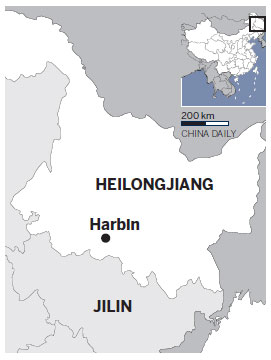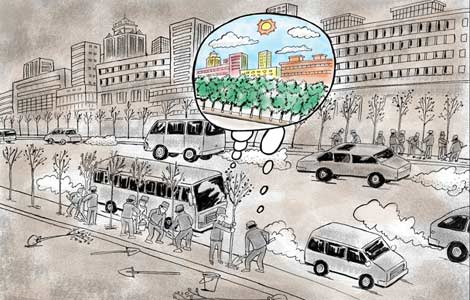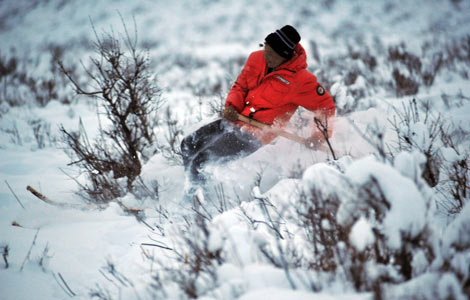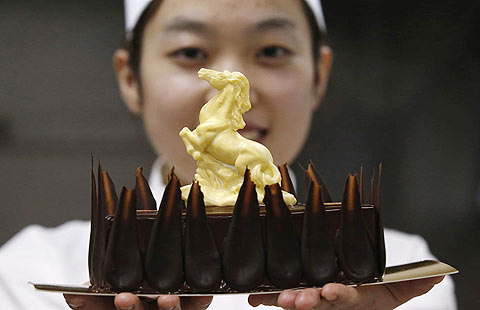Year-round charm
Updated: 2014-01-30 07:37
By Craig McIntosh (China Daily)
|
|||||||||||
With a rich history and natural beauty, Harbin attracts visitors for much more than its famous ice festival. Craig McIntosh reports.
World famous as the "City of Ice", Harbin has turned it sights on becoming a major destination for those looking for fun in the sun.
The northeastern metropolis is already second in the country's rankings of the top 10 summer resorts, while data show that a growing number of tourists from home and abroad now recognize it as a city for all seasons.
In the first half of 2013, Heilongjiang's provincial capital witnessed a 6 percent rise in visitor numbers, generating 26.9 billion yuan ($4.23 billion) in tourism revenue, 12 percent up on 2011, according to government figures.
Officials are now aggressively promoting the area's wealth of wetlands, as well as its culture and cuisine, to entice even more people to experience the beauty of this historical city.
"Harbin has many open-water areas, is rich in wetland resources and the geographical conditions are excellent, which offer great potential for its development as an international, high-end tourist resort," the city's publicity director Zhang Lixin told overseas reporters recently.
Authorities have invested huge sums of money creating green space in its urban core, including setting aside 10 million hectares as parkland and planting more than 30 million trees.
These parks vary in the environments and resources they provide, ranging from the newly completed Huanghe Park, a relatively commercial hot spot for those looking to relax, to Taiyangdao Park, or Sun Island, one of several scenic wetlands spread across the city's 10 districts.
Sun Island, on the northern bank of the Songhua River, for example, covers almost 4,000 hectares and is home to more than 300 species of animal, as well as 60 varieties of fish. Here, visitors can see (and feed) wild deer, swans and squirrels, explore the karst cave, and take a tour of Flower Garden, which is divided according to the signs of the zodiac.
Separated into three parts, the island's western reserve is famous as the venue for the annual Ice Sculpture Festival in winter, while the east is undergoing extensive but delicate urban development (a small marina has been built to cater to the growing number of yacht owners).
Meanwhile, in an attempt to protect the island's biodiversity, swathes of land - including a once-popular beach - have been closed to the public and made into conservation areas.
Harbin, one of the most populated provincial capitals in China, has also instigated revamps of several run-down, inner-city communities and shopping districts, most of which were chosen due to their historical importance.
Since 2007, the city has invested more than 1 billion yuan in projects aimed at "destroying all shantytowns and rundown areas", says Zhang, adding: "The goal is to restore the function of the downtown."
One such project from the 35 or so that have been launched is the so-called Chinese Baroque Block, a formerly bustling marketplace in central Nangang district.

Similar to the facelift given to Qianmen in Beijing, the two-story buildings in this network of streets in Harbin have been either demolished and rebuilt, or re-pointed and re-fitted. Authorities hope to attract big-name brands to the area, including luxury labels, while a plush hotel has already moved into one of the traditional square courtyards.
"Harbin is the 'youngest' of China's national historical and cultural cities, with only 100 years of history, but it ... contains some outstanding architecture," the publicity director says. "Comprehensive renovation of Central Street and Gogol Street, as well as the transformation of St. Sophia Cathedral and the surrounding area have added luster and beauty to this city."
The city is banking on that rich history, particularly its links to Russia.
St. Sophia Cathedral, a place of worship for Russian Orthodox Christians built in 1907, stands as a physical reminder of Harbin's colorful past in Daoli district. It fell into disrepair between 1958 and 1996, but authorities have spent large sums to restore the building's exterior, while inside an architectural art gallery boasts a collection of artifacts alongside an extensive exhibition of old photographs.
Just down the road stands another classic structure that has become a star attraction, the New Jewish Synagogue in Jingwei Street. Harbin was once home to one of the largest Jewish communities in the Far East, although today the temple is more of a museum housing artifacts from as early as the 1910s.
Harbin is not all about restoring the past, however. The city is also looking to create a better future and has invested heavily to boost entertainment and shopping options for residents and visitors alike. Arguably its most popular road, Central Street, boasts a host of clubs, bars, restaurants and many brand-name stores.
"The city's new brand (Charming Summer in Harbin) ... is the perfect fusion between man and nature, and reflects Harbin's fashion, romance, color and natural life in summer," Zhang adds.
Contact the writer at craigmcintosh33@gmail.com.
|
St.Sophia Cathedral, built in 1907,stands as a physical reminder of Harbin's colorful past. Wang Haibin / China Daily |
|
Russian artists perform at a theater in Harbin. Bai Linhe / for China Daily |
|
A snow-carving exhibition is staged on Sun Island every winter. Han Xin / for China Daily |
(China Daily 01/30/2014 page19)
Today's Top News
London goes all-out to ring in Lunar New Year
Chinese family infected with H7N9
HK imposes sanction on Philippines
More Chinese set to travel overseas
Experts call for detailed H7N9 rules
Huawei pledges more jobs in Europe
HK confirms H7N9 case, to cull 20,000 poultry
Chinese President to visit Paris to boost ties
Hot Topics
Lunar probe , China growth forecasts, Emission rules get tougher, China seen through 'colored lens', International board,
Editor's Picks

|

|

|

|

|

|








